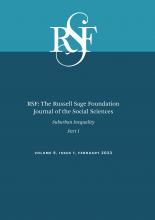Abstract
This article examines the most recent trends on neighborhood racial integration in New York—the country’s largest metropolitan area in 2019 with a total population of 19.2 million. We ask how the suburbanization of both immigration and poverty have transformed suburbs over the last two decades. We highlight four findings. First, ethnoracial diversification has led to a significant decline in nonintegrated neighborhoods and a sharp rise in integrated neighborhoods, but such a decline is more dramatic in suburbs than in cities. Second, White-integrated neighborhoods remain the most prevalent form of neighborhood integration in both cities and suburbs. Third, immigrant neighborhoods are more likely to be integrated in both suburbs and cities, but immigration’s impact on neighborhood integration in suburbs was stronger in 2000 than in 2019. Finally, the impacts of concentrated immigration, affluence, and disadvantage on neighborhood integration are consistent across suburbs and cities, pointing to convergent processes over time.
- © 2023 Russell Sage Foundation. Zapatka, Kasey, and Van C. Tran. 2023. “New Frontiers of Integration: Convergent Pathways of Neighborhood Diversification in Metropolitan New York.” RSF: The Russell Sage Foundation Journal of the Social Sciences 9(1): 52–83. DOI: 10.7758/RSF.2023.9.1.03. Support for this project was provided by a PSC-CUNY Award, jointly funded by The Professional Staff Congress and The City University of New York. Direct correspondence to: Kasey Zapatka, at kzapatka{at}gradcenter.cuny.edu, Department of Sociology, City University of New York, The Graduate Center, 365 Fifth Avenue, 6th floor, New York, NY 10016.
Open Access Policy: RSF: The Russell Sage Foundation Journal of the Social Sciences is an open access journal. This article is published under a Creative Commons Attribution-NonCommercial-NoDerivs 3.0 Unported License.






